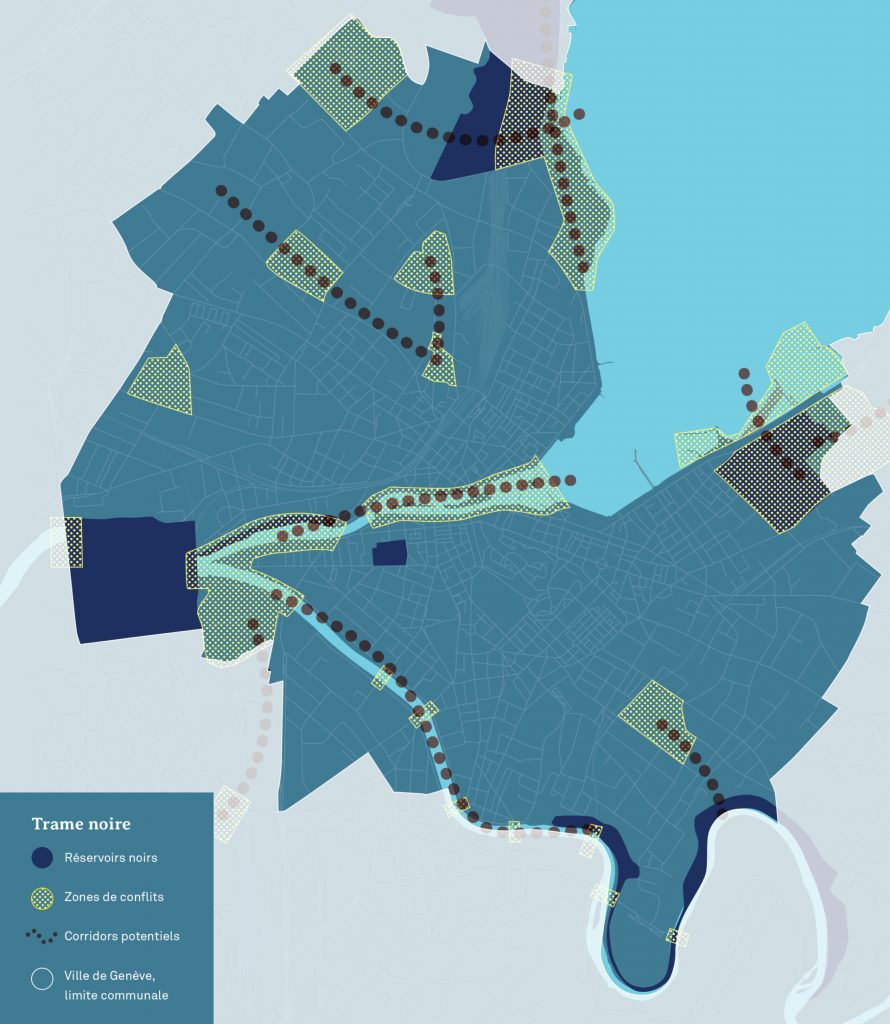Geneva Ready For A New Decade: The City Unveils Revision of Lighting Masterplan
The 2009-2019 Lighting Masterplan was the first document to provide the City of Geneva with a global vision for urban lighting. The City, a LUCI member, unveiled a full revision in 2021, setting up new objectives for the new decade. Its aim is to improve the preservation of biodiversity, while carefully monitoring the improvement of lighting for all users of the city. This revision was conducted by Radiance35, an associated member of the LUCI network.
Changing times, new objectives
The Lighting Masterplan is the tool that allows a city to plan and manage its public lighting. On the one hand, it proposes a global and strategic vision of lighting, with objectives to be achieved throughout the territory. On the other hand, it prescribes recommendations for concrete action on lighting.
The City of Geneva’s first Lighting Masterplan (2009-2020) established a map and a global analysis of public lighting. At the time, its objectives were mainly quantified in terms of energy and quality. Its implementation has made it possible to significantly reduce the electricity consumption of public lighting (beyond the 35% announced). Light pollution was limited, and the quality of the lighting was also improved. For the past ten years, the City of Geneva has been dimming the lighting of streets equipped with new luminaires. In these areas, between 10pm and 6am, lighting is now reduced by 40%.
However, the paradigms have changed in a decade. Today, it is no longer enough to “light better, consume less” (*), and the City wants to “light less, consume less“. While reducing energy bills, the new masterplan also aims to consider the impact of lighting on all living beings. Indeed, studies increasingly show that the excessive use of artificial light is harmful to biodiversity and its development.
The major challenge of the new Lighting Masterplan is therefore to find a balance: public spaces should be sufficiently lit, so that human activities can take place in a pleasant and safe manner, and sufficiently dark, to preserve biodiversity.
Finding the right balance between light and use
There are several ways to achieve this objective. For example, the Lighting Masterplan plans to limit light pollution. This excessive lighting can indeed be harmful to life. An added bonus of this is the opportunity for people to observe the starry sky!
The new Lighting Masterplan thus proposes recommendations to minimise unnecessary light emissions and to further reduce the impact of artificial lighting.
The idea is also to take advantage of the development of technology to provide lighting according to needs. LED (light-emitting diode) luminaires have become indispensable, since they allow very precise management of public lighting. This technology is being implemented in many LUCI member cities, such as Brussels (Belgium) or Rotterdam (Netherlands).
A “darkness grid” for Geneva
A darkness grid is an ecological ensemble where the level of darkness during the night is sufficient to allow the development of nocturnal biodiversity. It is made up of both biodiversity reservoirs, i.e. areas where species are the most numerous and varied, and ecological corridors that allow movement between the reservoirs. The central point of the revision of the Lighting Masterplan is the “darkness grid”, which makes it possible to locate the sensitive areas of the territory where special recommendations must be applied in terms of artificial lighting.
The map of the darkness grid of Geneva is the result of extensive work carried out with various biodiversity experts. First, the dark areas already present in the territory and not impacted by artificial lighting were identified. They constitute the black reservoirs, where darkness is to be preserved.
Secondly, the existing ecological complexes (the “green” and “blue” grids) were superimposed on this diagnosis. This made it possible to identify the conflict zones, where biodiversity is affected by artificial lighting.
Finally, movements of chiropterans (bats) were added to the two previous layers to indicate where the biological corridors are located and where the nocturnal territory is interrupted due to lighting. Observation of bat behaviour (*) is essential to identify areas to be protected from artificial lighting. Findings can then be extrapolated to other species.
The recommendations of the Lighting Masterplan
In addition to the new “darkness grid”, revision of the Masterplan entailed an analysis of the urban territory and human activities at night. The Lighting Plan is the result of these reflections and contains recommendations prescribing the type of lighting desired for each location. Depending on the situation and the predominant uses, the lighting level is defined as a “black zone”, “dark zone” or “urban zone”.
Other technical specifications are derived from this first recommendation. They make it possible to specify the lighting project as a whole, whether it involves illuminations (highlighting facades or other vertical elements) and/or public lighting (i.e. the “functional” lighting of streets, squares, etc.).
More information:
- On the City of Geneva’s website: https://www.geneve.ch/fr/themes/amenagement-construction-energie/urbanisme-planification/plan-
- On Radiance35’s website: https://www.radiance35.eu/fr/projects/revision-du-plan-lumiere-geneve/
(*) This is a link to a resource available on the LUCI Hub, the online knowledge-sharing platform created for LUCI members.


